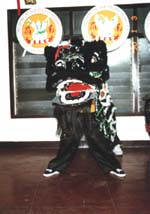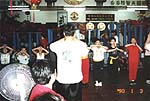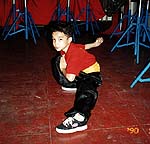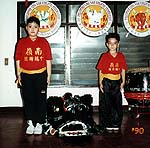|
By: Frances A. Ong
 The Philippine Ling Nam Athletic Federation was founded in 1958 by two Cantonese Kung-fu masters. Today, it is known as one of the best local Wu-shu schools and lion dancing troupes. It is a non-profit organization. The Philippine Ling Nam Athletic Federation was founded in 1958 by two Cantonese Kung-fu masters. Today, it is known as one of the best local Wu-shu schools and lion dancing troupes. It is a non-profit organization.
Some say the lion dance first took seed in an emperor's dream. Others say it was the ingenious plan of villagers to protect their crops. For centuries, the lion dance has been performed to usher in good luck, to express rebellion during a time of oppression (Ching Dynasty) and to entertain crowds. As an art form, it is encouraged because it is an important aspect of the Chinese heritage.
Dotting the Eye
The Lion starts out as a costume of cloth, onionskin and bamboo-- until you give it spirit. The lion dance master dips a brush in red pigment called chu-sha (shu-sza) but others use chicken blood and rice wine. He dots along the eyes, face and body of the lion to signify that the lion has come alive.
Dance of the lion
 Lion dances today are flashier than before but many things are the same. The performance begins with the opening salutations. Then the dancers enter the lion/s in a proper fashion, from their left sides. (Carelessly pulling the lion over their heads is being disrespectful towards the lion and the audience.) Then the performance can begin. There are many types of lions, each with a specific dance style. There are even more routines than there are lions. Some have a Laughing Buddha to tease or guide the lion. Others have puzzles (7 star, 5 star) and some deal with animals (snakes, crabs). The music of the gong, drum and cymbals is meant to punctuate the movements of the lion. When the performance is over, the lion bows to the audience, then the troupe says goodbye. Lion dances today are flashier than before but many things are the same. The performance begins with the opening salutations. Then the dancers enter the lion/s in a proper fashion, from their left sides. (Carelessly pulling the lion over their heads is being disrespectful towards the lion and the audience.) Then the performance can begin. There are many types of lions, each with a specific dance style. There are even more routines than there are lions. Some have a Laughing Buddha to tease or guide the lion. Others have puzzles (7 star, 5 star) and some deal with animals (snakes, crabs). The music of the gong, drum and cymbals is meant to punctuate the movements of the lion. When the performance is over, the lion bows to the audience, then the troupe says goodbye.
Proper conduct
 According to Arnold Buenviaje, the Assistant Chief Instructor at Ling Nam, there are rules of conduct that lion dancers must follow. It is bad form to sit with your legs splayed during a performance. Touching the lion's horn is disrespectful and if you're a girl, you shouldn't touch the lion at all. When passing a temple, the lion must bow three times. And if you meet another group, never raise your lion's head and never play or sniff at the other lion's tail. According to Arnold Buenviaje, the Assistant Chief Instructor at Ling Nam, there are rules of conduct that lion dancers must follow. It is bad form to sit with your legs splayed during a performance. Touching the lion's horn is disrespectful and if you're a girl, you shouldn't touch the lion at all. When passing a temple, the lion must bow three times. And if you meet another group, never raise your lion's head and never play or sniff at the other lion's tail.
The clan...
 Who are the people who make the lion come alive? The troupe at the Ling Nam kung-fu studio was surprisingly mixed. Many of the students are Filipino. One of the coaches, Dennis Fernandez, was one of the first Filipino students admitted into Ling Nam 10 years ago. He lives at the studio and is a Ling Nam scholar. He says 'Ling Nam is like a family. They take care of you and all they ask for is loyalty.' Many members joined young. A few like William Soon, Arnold Buenviaje and Dennis stayed to pass on what they learned. Who are the people who make the lion come alive? The troupe at the Ling Nam kung-fu studio was surprisingly mixed. Many of the students are Filipino. One of the coaches, Dennis Fernandez, was one of the first Filipino students admitted into Ling Nam 10 years ago. He lives at the studio and is a Ling Nam scholar. He says 'Ling Nam is like a family. They take care of you and all they ask for is loyalty.' Many members joined young. A few like William Soon, Arnold Buenviaje and Dennis stayed to pass on what they learned.
Young lions
 Talented lion dancing duo, Zach Nicholson Ho (9) and Aldrich Carag (10) have been partners for three months now. Zach directs the head of the lion because he's fast and light, while Aldrich takes charge of the tail because he's stronger. Their coach says they learn fast and move well together. A good lion dancer needs strength, flexibility and good footwork--but communication, coordination and cooperation between partners are indispensable. Most lion dancers take Wu shu (a martial art) because it is the basis for their steps, but both boys think lion dancing is more fun. Like the other kids at Ling Nam, it is hoped that they will be the instructors, Wu shu experts and lion dancers of the future. Talented lion dancing duo, Zach Nicholson Ho (9) and Aldrich Carag (10) have been partners for three months now. Zach directs the head of the lion because he's fast and light, while Aldrich takes charge of the tail because he's stronger. Their coach says they learn fast and move well together. A good lion dancer needs strength, flexibility and good footwork--but communication, coordination and cooperation between partners are indispensable. Most lion dancers take Wu shu (a martial art) because it is the basis for their steps, but both boys think lion dancing is more fun. Like the other kids at Ling Nam, it is hoped that they will be the instructors, Wu shu experts and lion dancers of the future.
Lioness?
 Girls are thought to be bad luck in a performance. It is only recently that the federation has considered letting female students train with the lions. Even though there are women lion dancers in China, they aren't allowed in many places like Malaysia. Perhaps it's time for change. Girls are thought to be bad luck in a performance. It is only recently that the federation has considered letting female students train with the lions. Even though there are women lion dancers in China, they aren't allowed in many places like Malaysia. Perhaps it's time for change.
|